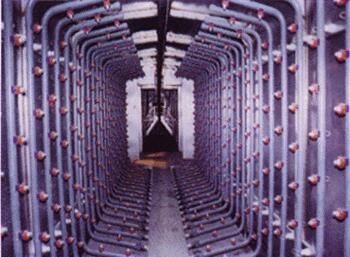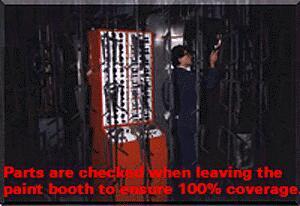MV COATINGS LIMITED
16 HOFFMAN ST.
KITCHENER ONTARIO
1-800 403 1958



What is Powder Coating?
Powder coating is an advanced method of applying a decorative and protective finish to a wide range of materials and products that are used by both industries and consumers. The powder used for the process is a mixture of finely ground particles of pigment and resin, which is sprayed onto a surface to be coated. The charged powder particles adhere to the electrically grounded surfaces until heated and fused into a smooth coating in a curing oven. The result is a uniform, durable, high quality, and attractive finish. Powder coating is the fastest growing finishing technology in North America, representing over 10% of all industrial finishing applications.
The process flow of a part at MV Coatings
Initially all product is washed and phosphated with our three stage wash systems. Our washers are equipped with hundreds of nozzles that are set to ensure that the entire surface of all parts are completely clean and free of all contaminants, such as dust, oil, grease.


After the wash the parts travel through the pre-dry oven to ensure that they are dry and ready for the powder to be applied.

When the parts reach our paint booth they have been checked for acceptable conditions four times, at the load area to ensure that the surface condition of the parts can be cleaned in our system.
Parts are checked and recorded after the wash system and the pre-dry oven to ensure that the systems are functioning properly.
They are also checked by the paint booth personnel before they enter the booth to make sure the parts are positioned correctly for the powder application, the parts are also masked off at this point if required to ensure paint does not get applied to areas that must be free of powder.

The powder is electrostatically applied using automatic and manual guns if required. At the end of our paint booth a systems operator checks the product with lights to ensure consistent coverage is achieved before the parts enter the cure oven. The parts then enter the cure oven at a temperature of 400 degrees Fahrenheit for an average of 20 minutes. The end result is a superior finish in terms of aesthetics and corrosion and impact resistance.All parts are 100% inspected and packaged for prompt delivery
Test results comparing Liquid paint VS Powder Coating
|
Name of Test |
Liquid Paint |
Powder Coating |
| Salt Spray |
240 to 336 hours |
500 to 1000 hours |
| Humidity |
96 hours |
240 hours |
| Paint Thickness |
0.5 to 0.75 mils avg. |
2 to 4 mils avg. |
| Marrability |
Average |
Excellent |
| Hardness (pencil test) |
HB |
2H to 4H |
| Impact (direct) |
N/A |
160 inch lbs |
| Impact (indirect) |
N/A |
160 inch lbs |
Powder Types and Specs
|
Hybrid |
Epoxy |
Urethane |
Polyester |
|
| Hardness |
good |
excellent |
good |
very good |
| Flexibility |
excellent |
excellent |
excellent |
excellent |
| Overbake Stability |
good |
fair |
good |
excellent |
| Corrosion Protection |
not recommended |
not recommended |
very good |
excellent |
| Chemical Resistance |
very good |
excellent |
very good |
very good |
| Application Properties |
very good |
excellent |
good |
very good |
What are the benefits of powder coating?
Reasons for the phenomenal growth in powder coatings over the last several years:
Environmental Compliance
Liquid finishing requires the use of solvents. These solvents require venting, filtering, and solvent recovery systems to control the emission of volatile organic compounds (VOC’s). But powder coating contains no solvents and therefore emits negligible, if any, polluting VOC’s into the atmosphere. Exhaust air from the coating booth can be safely returned to the coating room, and less oven air is exhausted to the outside, making the powder coating process a safer and cleaner finishing alternative.
And since the powder is dry, most powder coating overspray, up to 98% of it, can be readily retrieved and reused. The waste that results is negligible, and can be disposed of easily and economically.
Energy Savings
The absence of VOC’s is the powder coating process means that air used to exhaust the powder spray booth can be recirculated directly into the plant, eliminating the cost of heating or cooling the make-up air. Heating costs are also lower for the curing oven. While ovens that cure solvent-based coatings must heat and exhaust huge volumes of air to ensure that the solvent fumes do not reach a potentially explosive level, the exhaust required in powder coating ovens is lower, resulting in energy savings.
Efficiency
Greater operating efficiency with a powder system saves both time and money. No drying or flash-off time is required. Parts can be racked closer together on a conveyor, and pass more quickly through a production line, resulting in lower unit costs. More parts can be coated automatically, as powder coating does not run, drip, or sag, and results in significantly lower reject rates. With the use of appropriate application equipment, powder materials, and efficient recovery methods, one coat application and overall powder utilization efficiency of 95% to 98% are readily available. And if more than one color is required, color changes can be accomplished in a relatively short period of time.
Economy
While the factors above contribute to the economical benefits of powder coating, there are additional cost savings which include minimum operator training and supervision for a powder line, simplified clean-up of the operation, and easier compliance with federal and state regulations which saves both time and money.
Excellence of Finish
Powder coatings produce an attractive finish which offers excellent resistance to corrosion, heat, impact, abrasion, fading from sunlight, and extreme weather. Color selection is virtually unlimited with high and low gloss, metallic, and clear finishes available. Texture selections range from smooth surfaces to a wrinkled or matte finish, and rough textures designed for hiding surface imperfections. Both thin and thick film applications are possible to suit the particular requirements of the job.
Where is powder coating used?
Hundreds of products and parts are currently powder coated. The appliance industry benefits from powder coating on front and side panels of ranges and refrigerators, washer tops and lids, dryer drums, air conditioner cabinets, water heaters, dishwasher racks, and cavities of microwave ovens. Powder coating has also replaced porcelain enamel on many washer and dryer parts.
The automotive industry uses powder coating on wheels, bumpers, hubcaps, door handles, decorative trim and accent parts, truck beds, radiators, filters, and numerous engine parts. Powder coatings are also being developed and used as a primer surfacer and an anti-chip coating on hoods and body panels.
The architectural and building market powder coats aluminum extrusions used on frames for windows and doors, and modular furniture. Many highway and building projects use powder coating on light poles, guard rails, signs, posts, and fencing.
There are also innumerable everyday uses for powder coated products such as lighting fixtures, antennas, and electrical components. Farmers have powder coated tractors and farm equipment. Fitness buffs use golf clubs and golf carts, ski poles and bindings, snowmobiles, bicycles, and exercise equipment that are powder coated. Shop owners have powder coated display racks, shelves, store fixtures, and vending machines. Office workers use metal furniture, computer cabinets, mechanical pencils and pens, thumbtacks, and other desk accessories that are powder coated. Parents have powder coated baby strollers, cribs, metal toys, and wagons. And home owners have lawn mowers, snowblowers, barbecue grills, patio furniture, garden tools, electronic components, bathroom scales, tool boxes, and fire extinguishers which benefit from a powder coated finish.
Please send any questions or comments: mailto:admin@mur-van.com

